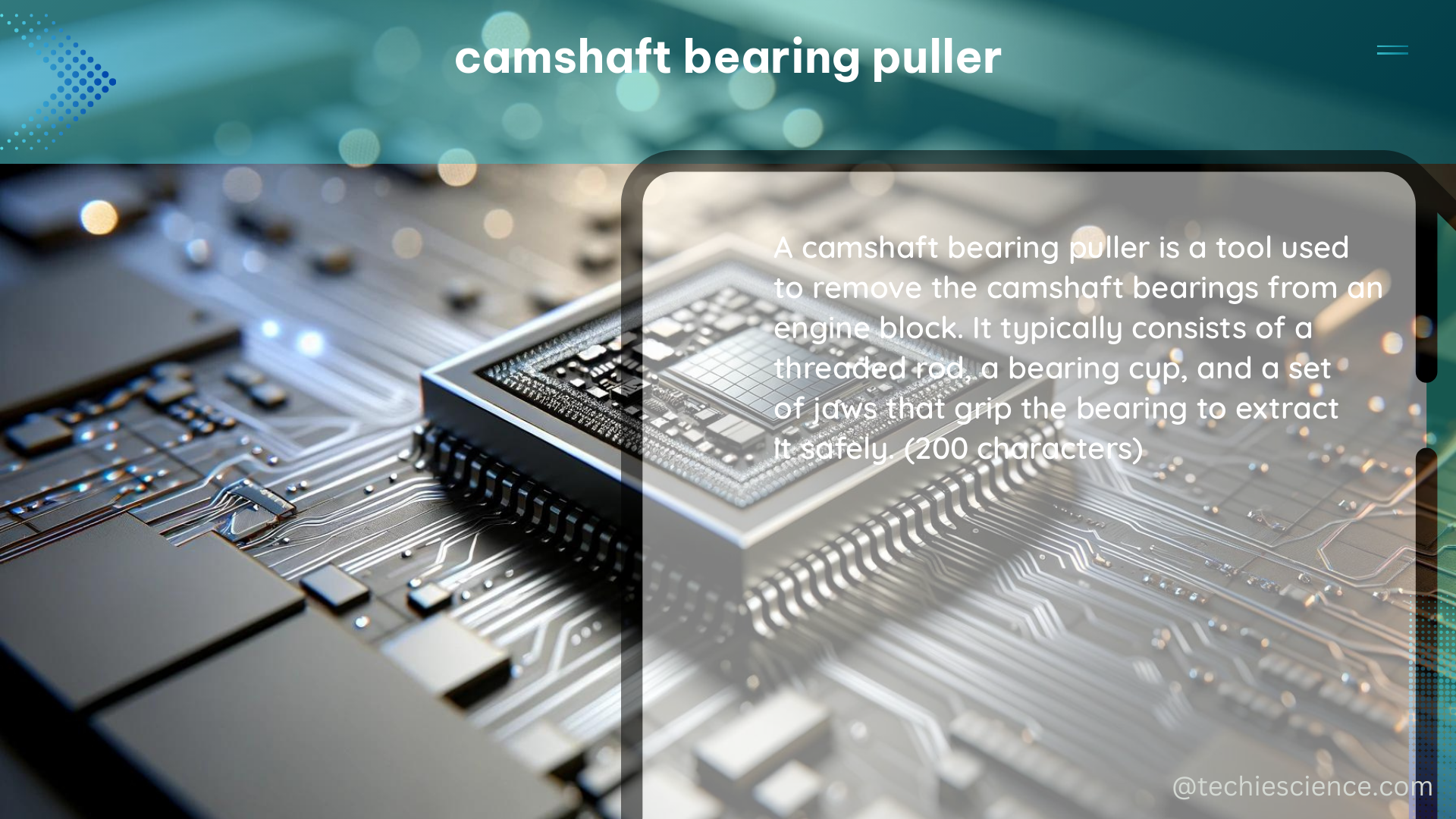Camshaft bearing pullers are specialized tools designed to facilitate the precise and damage-free removal and installation of camshaft bearings in engines. These tools are essential for maintaining the proper functioning and longevity of an engine, as camshaft bearings play a critical role in the engine’s performance and reliability.
Understanding the Key Aspects of Camshaft Bearing Pullers
When it comes to selecting and using camshaft bearing pullers, several key aspects need to be considered to ensure optimal performance and compatibility with your specific engine.
1. Tool Diameter
The diameter of the camshaft bearing puller must precisely match the diameter of the camshaft bearings in your engine. This is crucial for a secure and snug fit, which is essential for the successful removal and installation of the bearings. For instance, a 350 small block Chevy (SBC) camshaft bearing puller would have a diameter of 2.2 inches, which is suitable for the 350 SBC camshaft bearings.
2. Expansion Range
Some camshaft bearing pullers, such as the Lisle Universal Camshaft Bearing Installer, feature an expansion unit that can accommodate a range of camshaft bearing sizes. The expansion range is typically specified in the tool’s technical specifications, allowing users to determine if the tool will work with their specific engine and camshaft bearings. For example, the Lisle Universal Camshaft Bearing Installer has an expansion range of 1.75 to 2.75 inches, making it suitable for a wide variety of engine applications.
3. Tool Material
Camshaft bearing pullers are subjected to significant forces during the removal and installation process, so they must be constructed from durable materials to withstand these stresses. Typically, these tools are made of high-quality steel, with specifications such as a Rockwell hardness of 45-50 HRC and a tensile strength of 120,000 to 150,000 PSI. These material properties ensure the tool’s longevity and resistance to deformation or breakage.
4. Puller/Installer Design
The design of the camshaft bearing puller/installer can greatly impact its performance and ease of use. For example, the Lisle Universal Camshaft Bearing Installer utilizes an expansion unit that minimizes metal-to-metal contact with the bearings, reducing the risk of damage during the installation process. Additionally, some pullers feature ergonomic handles or leverage points to provide the user with greater control and mechanical advantage when removing or installing the bearings.
5. Instructions and Guidance
While not a quantifiable metric, clear and comprehensive instructions, as well as guidance on the proper usage of the camshaft bearing puller/installer, are crucial for successful and damage-free bearing installation. Users should carefully review the tool’s manual and seek out additional resources, such as online tutorials, forum posts, and instructional videos, to ensure they understand the correct techniques and best practices for using the tool.
Selecting the Right Camshaft Bearing Puller for Your Engine

When choosing a camshaft bearing puller, it’s essential to consider the specific requirements of your engine. Factors such as the engine make, model, and year, as well as the camshaft bearing diameter, will determine the appropriate puller to use. Consulting the tool’s technical specifications, manufacturer recommendations, and online resources can help you identify the correct puller for your application.
Proper Techniques for Using Camshaft Bearing Pullers
Utilizing camshaft bearing pullers correctly is crucial to avoid damage to the bearings, the camshaft, or other engine components. Here are some best practices to follow when using these specialized tools:
-
Thoroughly Clean the Work Area: Ensure the engine block and camshaft are free of debris, dirt, and contaminants before attempting to remove or install the bearings. This will help prevent the introduction of foreign particles that could compromise the integrity of the bearings or the engine.
-
Carefully Align the Puller: Properly align the camshaft bearing puller with the bearing to be removed or installed. Misalignment can lead to damage to the bearing or the surrounding components.
-
Apply Steady, Controlled Force: When using the puller, apply steady, controlled force to gradually remove or install the bearing. Avoid sudden or excessive force, as this can cause damage to the bearing or the engine.
-
Inspect Bearings and Components: Carefully inspect the bearings and other engine components for any signs of wear, damage, or irregularities before reassembly. Replace any worn or damaged parts to ensure the engine’s long-term performance and reliability.
-
Follow Manufacturer’s Instructions: Adhere strictly to the manufacturer’s instructions for the specific camshaft bearing puller you are using. This will help ensure the tool is used correctly and safely, minimizing the risk of damage to the engine.
Conclusion
Camshaft bearing pullers are essential tools for the precise and damage-free removal and installation of camshaft bearings in engines. By understanding the key aspects of these specialized tools, such as tool diameter, expansion range, material properties, design features, and proper usage techniques, you can ensure the successful maintenance and repair of your engine’s critical components. With the right camshaft bearing puller and the proper application of best practices, you can keep your engine running at its best for years to come.
References
- Third Gen Forum – If You Decide to Try
- Classic Oldsmobile Forum – Quick & Dirty Camshaft Bearing Tool Kit
- Blazer Forum – 4.3 Camshaft Bearing Removal/Installation Tool
- LS1Tech Forum – Recommendations for Cam Bearing Puller/Installer

The lambdageeks.com Core SME Team is a group of experienced subject matter experts from diverse scientific and technical fields including Physics, Chemistry, Technology,Electronics & Electrical Engineering, Automotive, Mechanical Engineering. Our team collaborates to create high-quality, well-researched articles on a wide range of science and technology topics for the lambdageeks.com website.
All Our Senior SME are having more than 7 Years of experience in the respective fields . They are either Working Industry Professionals or assocaited With different Universities. Refer Our Authors Page to get to know About our Core SMEs.